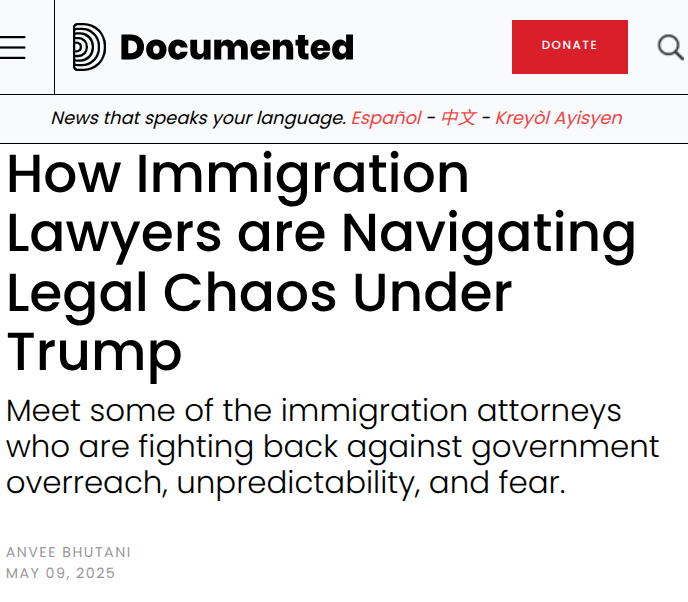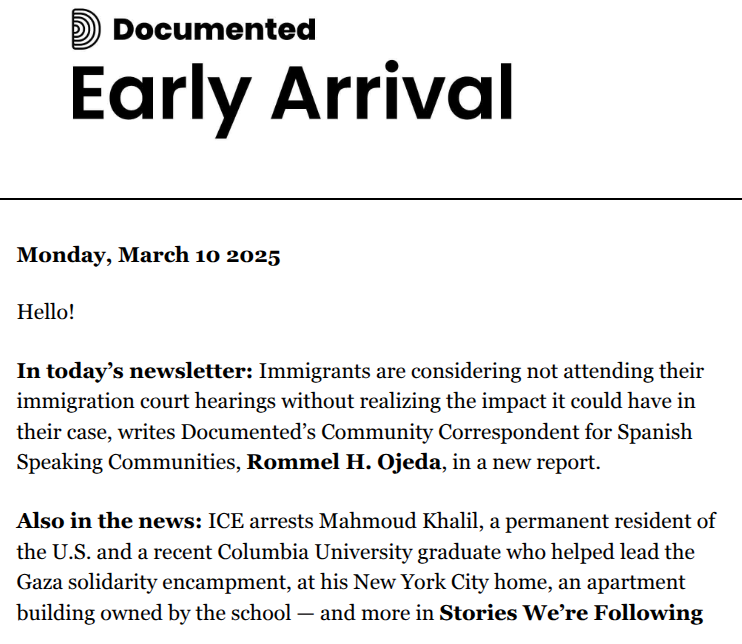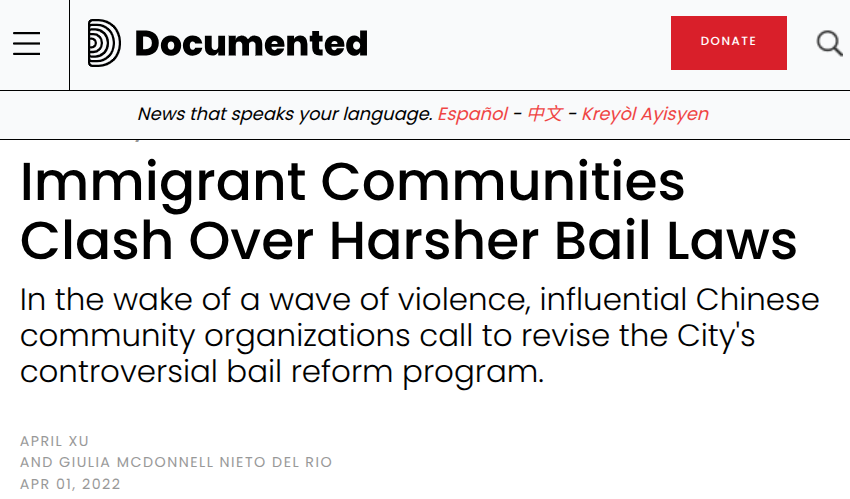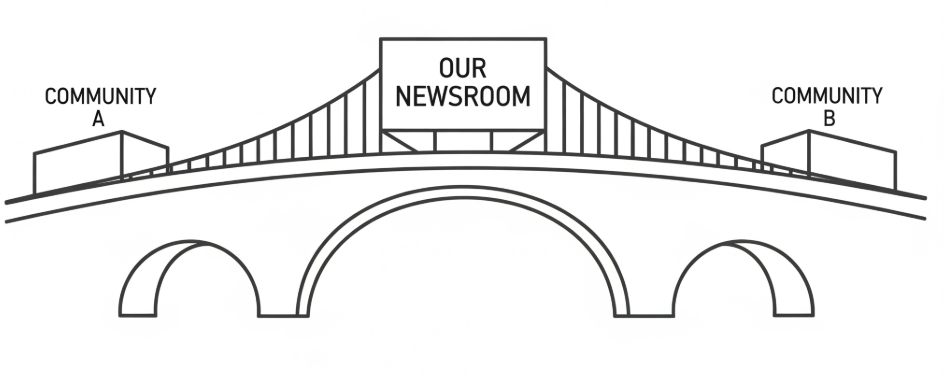![Documented | Documented Kreyol | Documented Semanal | Documented [Chinese characters] | Documented Early Arrival Documented | Documented Kreyol | Documented Semanal | Documented [Chinese characters] | Documented Early Arrival](https://rjionline.org/wp-content/uploads/sites/2/2025/09/riosn25091106-1024x576.png)
The bridge role: How newsrooms can connect immigrant communities with decision-makers
We built an editorial product to promote change and connect communities that have unequal access to power
In our previous column, we discussed the circular model that Documented has developed over the years to prioritize listening to your community to grow engagement with your news.
Documented serves the Chinese, Caribbean, and Hispanic communities of immigrants in New York City in Simplified Chinese, Haitian Creole, and Spanish, as well as a fourth audience of immigration professionals, served mainly in English by our flagship newsletter, Early Arrival.
If Documented’s mission is to serve immigrant communities, why did we decide to have a fourth product in English for lawyers, nonprofit workers, researchers, and other immigration professionals? Because this fourth audience is key to elevating the changing needs and points of view that we identify from immigrants, to those in positions of power who can take action. They are key to what we call our bridge role.
Newsrooms in bridge roles
For us, a bridge role in a news organization is the responsibility of connecting two (or more) communities or audiences that have unequal access to power and decision-making processes.
On one side, we have immigrant communities whose needs are often overlooked or misunderstood, and on the other side are the decision makers with the power to act and support in meeting those needs. Having a bridge role for us is much more than relaying information. It’s about listening and understanding immigrant needs — usually complex, hidden, or even unexpected — and making them visible to those who can make change happen.
By using our listening and understanding methodologies, we know that this decision-making audience uses our editorial content as a work asset and is made up mainly of lawyers, nonprofit workers, researchers, lobbyists, lawmakers, and people who work or volunteer in projects related to immigrants or immigration. They are primarily United States citizens and have or are looking for a job in the field of immigration.
With immigrant households paying $579.1 billion in taxes in 2022, including $35.1 billion paid by undocumented households, and with new policies restricting protections from immigrants, the professionals in this field are seeing both a surge in demand and a need to learn every day about new policies and how they affect immigrant populations.
And while it’s pretty straightforward to learn about what new policies the Government is implementing, it gets more difficult to assess how immigrant communities are being affected and are organizing at a grassroots level.
That’s where our bridge role comes in, as we are uniquely positioned to deliver these nuances because of our Listening and Understanding of these communities.
How our Bridge Role Works: Immigrant Communities to Decision Makers
In March this year, Community Correspondent Rommel Ojeda, who manages our WhatsApp Semanal product and interacts with the Hispanic immigrant community every day, received a question that started a conversation:
“One of our members, Carlos (main protagonist), reached out with an urgent question: ‘Is it safe to attend my court hearing?’ His friends warned him not to go; lawyers were asking for thousands of dollars to answer the question and take his case, and even his consulate offered no clear guidance,” Rommel said.
That single question revealed a much bigger issue. Misinformation spreading through immigrant networks was causing people to miss hearings, risking deportation orders in absentia (one of Carlos’ friends had already been ordered deported because he missed the hearing). Because Carlos trusted Documented to share his dilemma, we were able to identify an underreported consequence of immigration enforcement: fear and rumors were reshaping people’s legal decisions.’
For Rommel, “the message we received was essential” to see the level of misinformation and pointed us to the gaps in legal support. Documented decided to not only publish an investigation with Carlos’s story and expert sources, but also created an explainer guide on the real consequences of missing court.
Through multiple rounds of information and needs assessments with our audience of immigration professionals, we understand that they value our newsletter for actionable insights that serve as work assets. We have learned that they even share our explainers with their clients for guidance. That’s why we decided to feature these editorial pieces in our Early Arrival newsletter, bringing Carlos’ story to the attention of other lawyers and immigration professionals who could act upon this information.
In 2022, our reporters published an investigation on how the position of Chinese civic society organizations clashed directly with the most famous organizations that work in immigrant rights.
This reporting helped us deliver a unique angle to this story, as we were able to focus on the fact that two immigrant communities were confronted with a political issue.
Per our Listening and Understanding phases executed with the Chinese immigrant community, we knew that “public safety” ranked as a priority for this population. Thanks to the networks we’ve established with this community, we were alerted and invited to cover their points of view on this matter.
But because we also cover our fourth audience of immigration professionals, they invited us to cover their point of view and actions. Then, our editorial team was able to understand that there was, in fact, a conflict of perspectives.
We decided to cover the topic, highlight the differences, and feature these opposing viewpoints in all our channels.
Election coverage
We recognized that our bridge role could enhance our coverage of NYC’s Democratic primary, won by Zohran Mamdani. Via our WeChat group and direct messages, Documented’s senior reporter, April Xu, found insights that resulted in the publication of two stories:
Mamdani Won Big with Chinese Communities in South Brooklyn, But Faces a Tough Road Ahead
“Community members living around 86th Street in Brooklyn consistently raised concerns about the homeless shelter project, frequently sharing updates in our chat group and urging us to pay attention to the issue,” April explained. “Their concerns extend beyond the shelter itself, influencing their voting behavior, including their choices for mayoral and even presidential candidates. It reflects broader trends among Chinese immigrant voters.”
Chinese community input directly shaped these two stories written by April, giving them a unique angle. “It demonstrates how engagement with our audience can generate reporting that amplifies their voices and addresses the issues they care most about,” she added.
By publishing these stories, Documented elevated the concerns of Chinese immigrant voters and provided valuable insights to people in decision-making positions. The stories were not only published in Simplified Chinese but also in English. We shared them in our Early Arrival newsletter to help the community’s concerns cross the bridge and reach those who can make change happen..
How to try it yourself
We invite you and your newsroom to try our methodology and experience firsthand the difference you can make by implementing it. Here’s a step-by-step on how to do it.
Identify your newsroom’s flagship product. Is it a print newspaper? Your website? A newsletter or an Instagram account? A radio or TV show? Then, pick the primary audience that consumes that product. We will call it community A because it is your current audience.
Now identify an immigrant audience or community you would like to reach in your area. Here are some examples:
- Adult Cuban-Americans in Miami.
- Young Latinos in Seattle.
- Chinese People in New York
Then think again, and try to funnel it down to a more specific and “ideal” audience.
Are they adult Cuban immigrants or first-generation Cuban-Americans residing in Miami who are over 35 years old and lack English proficiency?
Are they Latino immigrants or first-generation Americans, younger than 35 years old, who live in Seattle and can speak English?
Is it your community formed by Chinese immigrants living in New York who lack English Proficiency?
This will be our community B. Here is an example of how we did it during the research phase of our expansion to launch Documented’s Chinese and Caribbean verticals:
Now that you have identified the two communities you would like to bridge, you are ready to start the “assessment” phase of both. But that will be addressed in our next column.
For now, think of the funneled audience you want to reach, community B, and how you could become a bridge between that audience and your community A.
Now answer the following questions:
What important insights from community B could you unearth to elevate and push in front of your primary core audience?
What better-informed decisions could the members of your current audience, community A, make that could be beneficial for both audiences?
Is there a subgroup in your core audience, community A, that holds any sort of decision making power? How could they be presented with the needs of your community B?
If there is a discrepancy in points of view between communities A and B, how could you present such differences to both audiences?
Hands-on instruction invitation
Would you like to learn more about our methodologies to engage with immigrant communities? We have just opened applications for our first-ever Community-Driven Journalism With Immigrants training program. Click here to learn more and apply for personalized coaching and stipend opportunities to serve immigrants in your area.
Cite this article
Ríos, Nicolás (2025, Sept. 15). The bridge role: How newsrooms can connect immigrant communities with decision-makers. Reynolds Journalism Institute. Retrieved from: https://rjionline.org/news/the-bridge-role-how-newsrooms-can-connect-immigrant-communities-with-decision-makers/





